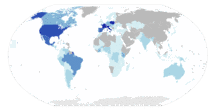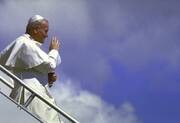John Paul II - the Pilgrim Pope
John Paul II - "These trips are visits to each local Church and demonstrate their place in making up the universality of the Church...
Each trip made by the Pope is 'an authentic pilgrimage to the living sanctuary of the People of God'.
.. the Pilgrim-Pope feels at home everywhere, even "among strangers". The proof of this lies in the relationship that they have with him."

During the 26½ years of his pontificate, John Paul II was a pilgrim to 129 different countries on 104 apostolic voyages, traveling 1,247,613 km (approx 750,000 miles). Below are listed the countries he visited in date order. They do not include the pilgrimages John Paul II made within Italy (146 visits) nor his 748 visits within the Diocese of Rome (he took his role as Bishop of Rome very much to heart) or to Castel Gandolfo.
1 - Dominican Republic, Mexico & the Bahamas
25th January - 1st February
John Paul II: "The journey wishes to be first and foremost a pilgrimage of faith. The Pope is going to kneel before the marvellous image of the Madonna of Guadalupe, in Mexico, to invoke her motherly assistance and her protection on his pontifical service; to say to her again, with a force increased by his immense new tasks: "Totus tuus sum Ego!" and to put in her hands the future of evangelization in Latin America.
The Pope, furthermore, is going to other areas of the New World as a Messenger of the Gospel for the millions of brothers and sisters who believe in Christ. He wants to know them, embrace them and tell them all — children, young people men, women, workers, peasants, professionals — that God loves them, that the Church loves them, that the Pope loves them, and also he wants to receive from them encouragement and example of their goodness, their faith." (25.01.79)
2 - Poland
2nd - 10th June
3 - Ireland, United Nations & the United States
29th September - 8th October
4 - Turkey
28th - 30th November
5 - Zaire (now DR Congo), Congo, Kenya, Ghana, Upper Volta (now Burkina Faso) & Ivory Coast
2nd - 12th May
6 - France
30th May - 2nd June
7 - Brazil
30th June - 12th July
8 - West Germany
15th - 19th November
9 - Pakistan, Philippines, Guam, Japan & USA
16th - 27th February
10 - Nigeria, Benin, Gabon & Equatorial Guinea
12th - 19th February
11 - Portugal
12th - 15th May
12 - Great Britain
28th May - 2nd June
13 - Argentina
10th - 13th June
14 - Switzerland
15th June
15 - San Marino
29th August
16 - Spain
31st October - 9th November
21 - USA, Korean Republic, Papua-New Guinea, Solomon Islands & Thailand
2nd - 12th May
22 - Switzerland
12th - 17th June
23 - Canada
9th - 21st September
24 - Spain, Dominican Republic & Puerto Rico
10th - 13th October
25 - Venezuela, Ecuador, Peru, Trinidad & Tobago
26th January - 6th February
26 - Netherlands, Luxembourg & Belgium
11th - 21st May
27 - Togo, Ivory Coast, Cameroon, Central African Republic, Zaire (now DR Congo), Kenya & Morocco
8th - 19th August
28 - Liechtenstein
8th September
29 - India
31st January - 11th February
30 - Colombia & Saint Lucia
1st - 8th July
31 - France
4th - 7th October
32 - Bangladesh, Singapore, Fiji Islands, New Zealand, Australia & Seychelles
18th November - 1st December
45 - Cape Verde, Guinea-Bissau, Mali, Burkina Faso & Chad
25th January - 1st February
46 - Czechoslovakia (now Czech Republic & Slovakia)
21st - 22nd April
47 - Mexico & the Dutch Antilles (now Curaçao)
6th - 14th May - Beatification of Juan Diego & other Servants of God
48 - Malta
25th - 27th May
49 - Tanzania, Burundi, Rwanda & the Ivory Coast
1st - 10th September
54 - Senegal, the Gambia & Guinea
19th - 26th February
55 - Angola, São Tomé & Príncipe
4th - 10th June
56 - Dominican Republic
9th - 14th October
62 - Croatia
10th - 11th September
63 - The Philippines for World Youth Day Manila, Papua New Guinea, Australia & Sri Lanka
11th - 21st January
64 - Czech Republic & Poland
20th - 22nd May
65 - Belgium
3rd - 4th June
66 - Slovakia
30th June - 3rd July
67 - Cameroon, South Africa & Kenya
14th - 20th September
68 - United States
4th - 9th October
1996
1997
75 - Bosnia-Herzegovina
12th - 13th April
76 - Czech Republic
25th - 27th April
77 - Lebanon
10th - 11th May
78 - Poland
31st May - 10th June
79 - World Youth Day Paris
21st - 24th August
80 - Brazil
2nd - 6th October
1998
1999
Jubilee Year 2000
2001
2002
96 - Azerbaijan & Bulgaria
23rd - 26th May
97 - World Youth Day Toronto, Guatemala & Mexico
23rd July - 2nd August
98 - Poland
16th - 19th August
2003
99 - Spain
3rd - 4th May
100 - Croatia
5th - 9th June
101 - Bosnia-Herzegovina
22nd June
102 - Slovakia
11th - 14th September
2004
103 - Switzerland
5th - 6th June
104 - Lourdes
14th - 15th August, the Feast of the Assumption of the Blessed Virgin Mary
John Paul II:
"These trips are visits to each local Church and demonstrate their place in making up the universality of the Church. As I have already asserted before, each trip made by the Pope is "an authentic pilgrimage to the living sanctuary of the People of God"
With this view, the Pope travels, sustained, as Peter, by the prayer of the entire Church, to proclaim the Gospel, to "confirm his brothers in faith", to console the Church, to encounter man. These are travels of faith, of prayer, which are focused around the meditation and the proclamation of the Word of God, the Eucharistic celebration, the invocation of Mary. Also, they are the occasions for itinerant catechesis, of evangelical proclamation in the spreading, at all latitudes, of the Gospel and of the Apostolic Magisterium spread to all the spheres of the world today ..
This and this alone is the goal of the Pilgrim-Pope even though many attribute different reasons for this. The role of the shepherds is to "assemble the People of God"according to the different possibilities and dimensions. The Church recognises herself in this "assembly" and, at the same time, realises herself. Among the different methods of realising Vatican II, this seems to be fundamental and of particular importance. This is the apostolic method: this is Peter's method and even more so Paul's method. How can one not be touched when reading the travels of the Apostle of the Gentiles in the way the Acts propose them to us in such a vivacious way? How can we avoid being moved by such courage, by this challenge regarding all obstacles, all difficulties? The technical means offered b our era facilitate today, this method and, in a certain sense, "oblige" us to follow it. John XXIII already presented this method, but Paul VI brought it to its full realization. Certainly John Paul I would have continued it ...
... One can say that after Vatican Council II .. the Pilgrim-Pope feels at home everywhere, even "among strangers". The proof of this lies in the relationship that they have with him ...
... Everywhere, in a free way with relationship to tradition and religious appurtenance, the Pope carries the deep consciousness that God wishes that "all be saved and achieve the knowledge of the truth"; the consciousness of the redeeming work of Christ that is realized by His blood being shed for all men, without distinguishing between believers and non-believers. The Pope also carries with him the consciousness of the universal brotherhood of all men, in whose name they must feel united around the vast and difficult problems of the entire human family: peace, liberty, justice, hunger, culture and man other problems .."
- 28th June 1980 - speech to the Roman Curia, which you can also read in Italian, Portuguese & Spanish.








